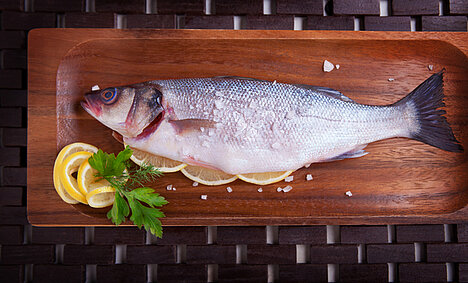Sea bass

Sea bass is a popular edible fish that is also suitable for dogs. But what is sea bass and what are the advantages and disadvantages for your four-legged friend? In this article, you'll find out everything you need to know about sea bass for dogs.
What is sea bass?
Sea bass is the name for several species of fish from the bass family, which are mainly found in the Atlantic, Mediterranean and North Sea. The best-known species are the European sea bass and the striped bass. Sea bass has white, firm and lean meat with a mild taste. It is suitable for frying, grilling, steaming or baking.
What are the benefits of sea bass for dogs?
Sea bass is a tasty and healthy fish for dogs that has many benefits for your pet's well-being. Here are some of them:
- Sea bass contains high-quality protein, which is important for muscle building and cell renewal.
- Sea bass is rich in omega-3 fatty acids, which have an anti-inflammatory effect and promote healthy skin and coat. They can also strengthen the cardiovascular and immune systems.
- Sea bass provides many vitamins, such as vitamins A, B12, D and E, which are important for vision, nerve function, bone formation and cell protection.
- Sea bass is easy to digest and digestible, which is particularly beneficial for dogs with sensitive stomachs or allergies.
What are the disadvantages of sea bass for dogs?
While sea bass is a healthy fish for dogs, it does have some disadvantages that you should be aware of. Here are some of them:
- Sea bass can contain bones that can harm your dog if he swallows them. Therefore, you should always bone or fillet the fish well before giving it to your dog.
- Seabass can contain heavy metals or other harmful substances that can accumulate in the fish's tissue. You should therefore pay attention to the origin and quality of the fish and not feed it too often.
- Sea bass can contain too much iodine, which can lead to hyperthyroidism. You should therefore not combine the fish with other iodine-rich foods or give your dog additional iodine.
How do you feed sea bass to your dog?
If you want to feed your dog sea bass, there are a few things you should bear in mind:
- Always feed the fish cooked or cooked, never raw. Raw fish meat can contain parasites or bacteria that can harm your dog.
- Always feed the fish without skin and without bones or bones. These can cause injuries to your dog's mouth or digestive tract or cause an intestinal blockage.
- Always feed fish in moderation and not as the sole food. Too much fish can lead to an oversupply of certain nutrients or displace other nutrients. Too much fish can also lead to diarrhea or vomiting.
- Always feed a variety of fish and not always the same type. Different types of fish have different nutrient profiles and tastes. This allows you to offer your dog a balanced and tasty diet.
Where can you get sea bass for your dog?
You can buy sea bass in various forms for your dog:
- Fresh or frozen sea bass: You can buy the fish in the supermarket, at the market or from a fishmonger. Pay attention to the freshness and quality of the fish and process it as soon as possible after purchase.
- Dried sea bass: You can buy the fish as a snack or treat for your dog or dry it yourself. Pay attention to the ingredients list and avoid products with additives or sugar.
- Canned or jarred sea bass: You can buy the fish as wet food or supplementary food for your dog. Pay attention to the list of ingredients and avoid products with preservatives or flavor enhancers.
- Sea bass in dry food: You can buy the fish as dry food or complete food for your dog. Pay attention to the list of ingredients and avoid products with cereals, soy or other fillers.
Sea bass is a tasty and healthy fish for dogs that has many benefits for your pet's well-being. However, you should also be aware of the possible disadvantages and prepare and dose the fish correctly. If you want to feed your dog sea bass, you have various options for buying it or preparing it yourself. It is important that you pay attention to the quality and origin of the fish and feed it a varied diet.
If you notice any signs of hypersensitivity or poisoning in your dog, you should see your vet immediately. We are not a substitute for a vet, but we try to be as accurate as possible. Every dog reacts differently and we recommend you get a second opinion or consult your vet if in doubt.
Stay healthy and take good care of your four-legged friend!😊